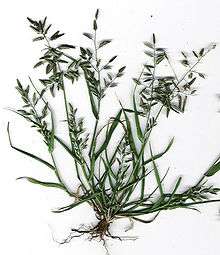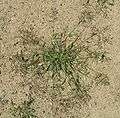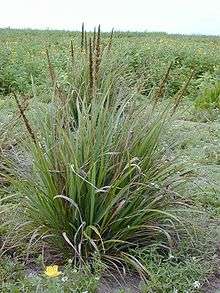Eragrostis
Eragrostis is a large and widespread genus of plants in the grass family, found in many countries on all inhabited continents and many islands.[4][5][6][7][8][9][10]
| Eragrostis | |
|---|---|
 | |
| Eragrostis cilianensis Maui, Hawai'i | |
| Scientific classification | |
| Kingdom: | Plantae |
| Clade: | Tracheophytes |
| Clade: | Angiosperms |
| Clade: | Monocots |
| Clade: | Commelinids |
| Order: | Poales |
| Family: | Poaceae |
| Subfamily: | Chloridoideae |
| Tribe: | Eragrostideae |
| Subtribe: | Eragrostidinae |
| Genus: | Eragrostis Wolf[1] |
| Type species | |
| Eragrostis eragrostis (syn of E. cilianensis) | |
| Synonyms[3] | |
| |
Eragrostis is commonly known as lovegrass[11] or canegrass. The name of the genus is derived from the Greek words ἔρως (eros), meaning "love", and ἄγρωστις (agrostis), meaning "grass".[12]
Lovegrass is commonly used as livestock fodder. The seeds appear to be of high nutritional value for some animals, but they are also very tiny and collecting them for human food is cumbersome and hence uncommon. A notable exception is teff (E. tef), which is used to make traditional breads on the Horn of Africa, such as Ethiopian injera and Somalian laxoox. It is a crop of commercial importance. E. clelandii and E. tremula are recorded as famine foods in Australia and Chad, respectively.[13]
Other species, such as E. amabilis, are used as ornamental plants. E. cynosuroides is used in the pūjā rites in the Hindu temple at Karighatta. Bahia lovegrass (E. bahiensis) is known as a hyperaccumulator of caesium-137 and can be grown to remove the highly toxic radioactive atoms from the environment. Weeping lovegrass (E. curvula) has been planted extensively to prevent soil erosion.
Seed dispersal is often done by passing animals; the grains' hooks latch on to fur or hair, or to clothes. Others are wind or gravity dispersed. Several herbivores feed on lovegrass, including invertebrates such as the caterpillars of the Zabulon skipper (Poanes zabulon) and vertebrates. The extinct bluebuck (Hippotragus leucophaeus) was known to graze these grasses. The dense bunches also provide cover for small animals such as the rare Botteri's sparrow (Aimophila botterii). Lovegrasses may be important groundcover on oceanic islands like Laysan, where other plants are rare.
Taxonomy
Eragrostis is the type genus of the tribe Eragrostideae.[14][15]
- Formerly included[3]
Many species now considered better suited to other genera, including Cladoraphis Coelachyrum Desmazeria Diplachne Ectrosia Festuca Harpachne Poa etc.
 Eragrostis atropioides flowers
Eragrostis atropioides flowers weeping lovegrass (Eragrostis curvula)
weeping lovegrass (Eragrostis curvula) little lovegrass (Eragrostis minor)
little lovegrass (Eragrostis minor)
References
- "Genus: Eragrostis Wolf". Germplasm Resources Information Network. United States Department of Agriculture. 9 March 1999. Archived from the original on 29 June 2011. Retrieved 25 February 2011.
- "IPNI Plant Name Details". IPNI.org. Retrieved 29 March 2017.
- "World Checklist of Selected Plant Families: Royal Botanic Gardens, Kew". Kew.org. Retrieved 29 March 2017.
- Wolf, Nathanael Matthaeus von 1776. Genera Plantarum Vocabulis Characteristicis Definita 23.
- Atlas of Living Australia, Eragrostis Wolf Love Grasses
- Flora of China Vol. 22 Page 471, 画眉草属 hua mei cao shu Eragrostis Wolf, Gen. Pl. 23. 1776.
- "Eragrostis in Flora of Pakistan @ efloras.org". Efloras.org. Retrieved 29 March 2017.
- Altervista Flora Italiana, genere Eragrostis
- "2013 BONAP North American Plant Atlas. TaxonMaps". BONAP.net. Retrieved 29 March 2017.
- "Threatened Species Programme - SANBI Red List of South African Plants". SANBI.org. Retrieved 29 March 2017.
- "Eragrostis". Integrated Taxonomic Information System. Retrieved 4 March 2011.
- Quattrocchi, Umberto (2006). CRC World Dictionary of Grasses. II E-O. CRC Press. p. 805. ISBN 978-0-8493-1303-5.
- Freedman, Robert (1998): Famine Foods – Poaceae or Graminae. Version of 6 March 1998. Retrieved 12 November 2007.
- H., Harvey, William; Wilhelm, Sonder, Otto; T., Thiselton-Dyer, William (1 January 1897). "Flora capensis". BiodiversityLibrary.org. 7. Retrieved 29 March 2017.
- "Tropicos - Name - Eragrostideae Stapf". Tropicos.org. Retrieved 29 March 2017.
External links


- Interactive Key to Eragrostis of North America